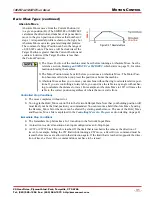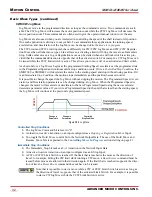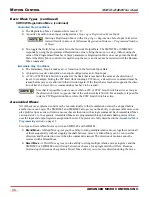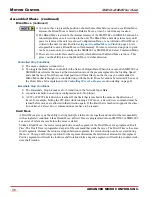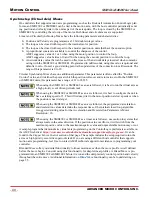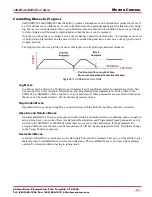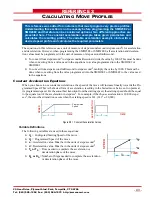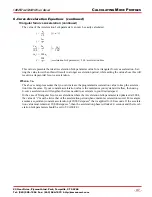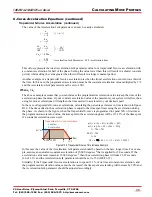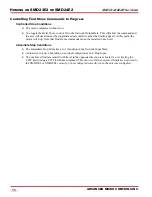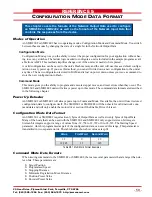
C
ALCULATING
M
OVE
P
ROFILES
SMD23E2 and SMD24E2 User’s Manual
ADVANCED MICRO CONTROLS INC.
44
Constant Acceleration Equations (continued)
Figure R3.1 gives the equations to calculate Time, Distance, and Acceleration values for a constant accelera-
tion move.
Table R3.1 Acceleration Equations
If the sum of the D
A
and D
D
values of the move is
less than
the total number of steps in the move, your move
will have a Trapezoidal profile.
If the sum of the D
A
and D
D
values of the move is
equal to
the total number of steps in the move, your move
will have a Triangular profile and your move will reach the Programmed Speed before it begins to decelerate.
If the sum of the D
A
and D
D
values of the move is
greater than
the total number of steps in the move, your
move will have a Triangular profile and it
will not
reach the Programmed Speed before it begins to decelerate.
As an example, lets assume the values in table R3.2 for a move profile.
Table R3.2 Sample Values
Time to accelerate: T
A
= (V
P
– V
S
)/a = (100,000 - 141)/20,000 = 4.993 seconds
Time to decelerate: T
D
= (V
P
– V
S
)/d = (100,000 - 141)/25,000 = 3.994 seconds
Distance to Accelerate: D
A
= T
A
*(V
P
+ V
S
)/2 = 4.993 * (100,000 + 141)/2 = 250,002 steps
Distance to Decelerate: D
D
= T
D
*(V
P
+ V
S
)/2 = 3.994 * (100,000 + 141)/2 = 199,982 steps
Total Distance needed to accelerate and decelerate: 250,002 + 199,982 = 449,984 steps
If a move with the above acceleration, deceleration, starting speed, and programmed speed has a length
greater than 449,984 steps, the SMD23E2 or SMD24E2 will generate a Trapezoidal profile. If the move is
equal to 449,984 steps, the unit will generate a Triangular profile and the it will output one pulse at the pro-
grammed speed. If the move is less than 449,984 steps, the unit will generate a Triangular profile and the pro-
grammed speed will not be reached.
In the case of a Triangular profile where the programmed speed is not reached, it is fairly easy to calculate the
maximum speed (V
M
) attained during the move. Because the move is always accelerating or decelerating, the
total distance traveled is equal to the sum of D
A
and D
D
.
D
A
= T
A
*(V
M
+ V
S
)/2 and T
A
= (V
M
– V
S
)/a. By substitution:
D
A
= (V
M
– V
S
)/a * (V
M
+ V
S
)/2 = (V
M
2
– V
S
2
)/2a. By the same method,
D
D
= (V
M
2
– V
S
2
)/2d.
Therefore, total distance traveled =
D
A
+ D
D
= (V
M
2
– V
S
2
)/2a + (V
M
2
– V
S
2
)/2d.
In the case where the acceleration and deceleration values are equal, this formula reduces to:
D
A
+ D
D
= (V
M
2
– V
S
2
)/a
Acceleration Type
T
A
or T
D
(Time to Accelerate
or Decelerate)
D
A
or D
D
(Distance to Accelerate
or Decelerate)
a
(Average
Acceleration)
Linear
T
A
= (V
P
– V
S
)/a
D
A
= T
A
*(V
P
+ V
S
)/2
a = (V
P
2
– V
S
2
)/2D
A
Name
Value
SMD23E2 or SMD24E2
Parameter Values
Acceleration (a)
20,000 steps/sec
2
20
Deceleration (d)
25,000 steps/sec
2
25
Starting Speed (V
S
)
141 steps/sec
141
Programmed Speed (V
P
)
100,000 steps/sec
100,000


